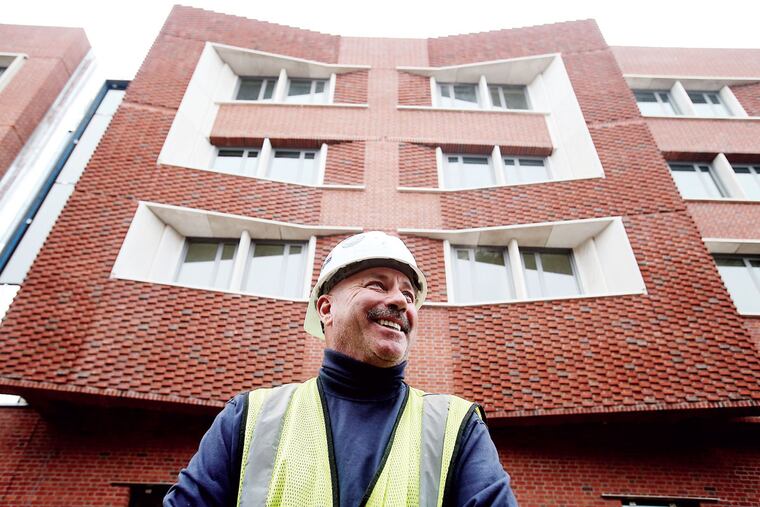While construction booms, numbers of qualified workers lags
Turkey topped the menu at the bricklayers' retiree luncheon last month, but union president Dennis Pagliotti had something more serious on his plate.

Turkey topped the menu at the bricklayers' retiree luncheon last month, but union president Dennis Pagliotti had something more serious on his plate.
"Come back to work," he said he told the bricklayers and masons before they chowed down at the union hall in Northeast Philadelphia. "We're going to need you. Work is going to be so busy."
Jobs in construction are rising - but there aren't enough qualified candidates to keep up with demand. Nationally, four in five contractors report being worried about labor shortages.
After years when unemployment in the construction trades topped 25 percent, the demand is putting pressure on a system now starved for workers.
Trade unions are beefing up apprentice classes after years when new enrollees could be counted in the single digits.
In Montgomery County, the association of open-shop building contractors mentors high school students in a club that lets them experience the construction process.
Most groups - union and non-union - are hustling hard to attract young people who, they say, seem more interested in going to college than working with their hands, sometimes in harsh weather.
Some unions have called in retirees, including the Bricklayers and Allied Craftworkers Local 1, the Boilermakers Local 13, and International Union of Operating Engineers Local 542, the crane operators.
"We couldn't fill the jobs," said Walter "Butch" Bennett, a business agent at Local 542. He said a handful of retirees has gone back to work.
"During the downturn, we lost a lot of people," said Mary Tebeau, president of Associated Builders and Contractors of Eastern Pennsylvania.
"Folks who left the industry have retired or moved to another industry. We don't think we're going to get them back."
In this region, the start of fall eased the need for construction workers, said Emily Bittenbender, managing partner of Bittenbender Construction LP.
"We're fine again. Our work is slowing down," said Bittenbender, who also chairs the General Building Contractors Association in Philadelphia.
"During the summer work, people were crazy and understaffed."
The region's economy, she said, relies on "meds and eds" and the education part means classroom refurbishing and other school repairs occur during the summer, when students are on vacation.
But that coincided with peak construction demand during warm weather.
The lack of workers "slows the work and drives up the cost," said economist Bernard Markstein of Markstein Advisors. "Labor costs will rise relatively rapidly" as wages rise.
But rising costs "create incentives where, if you can use capital to replace people, you will," he said, referring to an automated bricklaying machine.
That's the future. In the meantime, Albert Chiapperta, general foreman at Dan LePore & Sons Co., said he's happy to have retired bricklayers on the job at College House, a student housing project at the University of Pennsylvania that the Conshohocken-based masonry firm is helping to build.
"I like to have them mixed in because of their experience," he said. "They don't waste a move."
On Nov. 9, one of the returned retirees fell about 26 feet while on the job at College House.
"I turned 67 in the hospital," said Joe Duff, of Northeast Philadelphia who retired during the recession, but came back last year. "I would actually think about going back to work," Duff said, grateful that he's alive. "Don't tell my girlfriend that."
Fellow bricklayer and retiree Rocco Matteo Jr. wasn't at last month's retiree lunch in the union hall.
That's because he was too busy working. When the recession hit, he retired at 57, took the grandkids to ball games and went stir-crazy in Springfield, Delaware County.
"Construction was opening up," said Matteo, 61. "They were happy to have retirees coming back."
For the most part, union leaders say, they aren't turning to retirees to fill their labor calls.
"It's a young people's business," said Joseph T. Ashdale, who chairs District 21 of the International Union of Painters and Allied Trades.
The trick, he said, is to forecast the size of the incoming apprentice class so they can work during their four years of study and be employed as journeymen. "That's the toughest part of my job," he said, "figuring out how busy we're going to be four years from now."
215-854-2769
@JaneVonBergen
Shortages On the Job Site
StartText
Construction payrolls, although rising, have not reached pre-recession levels, causing gaps.
National:
Top: 8.0 million, August 2006.
Bottom: 5.0 million, January, 2011.
Now: 6.7 million.
Camden, Gloucester, Burlington Counties:
Top: 26,500, August 2007.
Bottom: 17,200, February 2011.
Now: 23,200.
Montgomery, Bucks, Chester Counties:
Top: 60,000, July 2006.
Bottom: 39,700, February 2010.
Now: 55,000.
Philadelphia, Delaware Counties:
Top: 25,400, May 2006.
Bottom: 18,000, February 2011.
Now: 22,400.
SOURCE: U.S. Bureau of Labor Statistics, not seasonally adjusted.EndText